Economic Assessment of the Use Value of Geospatial Information
Abstract
:1. Introduction
2. Estimating the Economic Impacts of Geospatial Technology: A Model of Technological Innovation
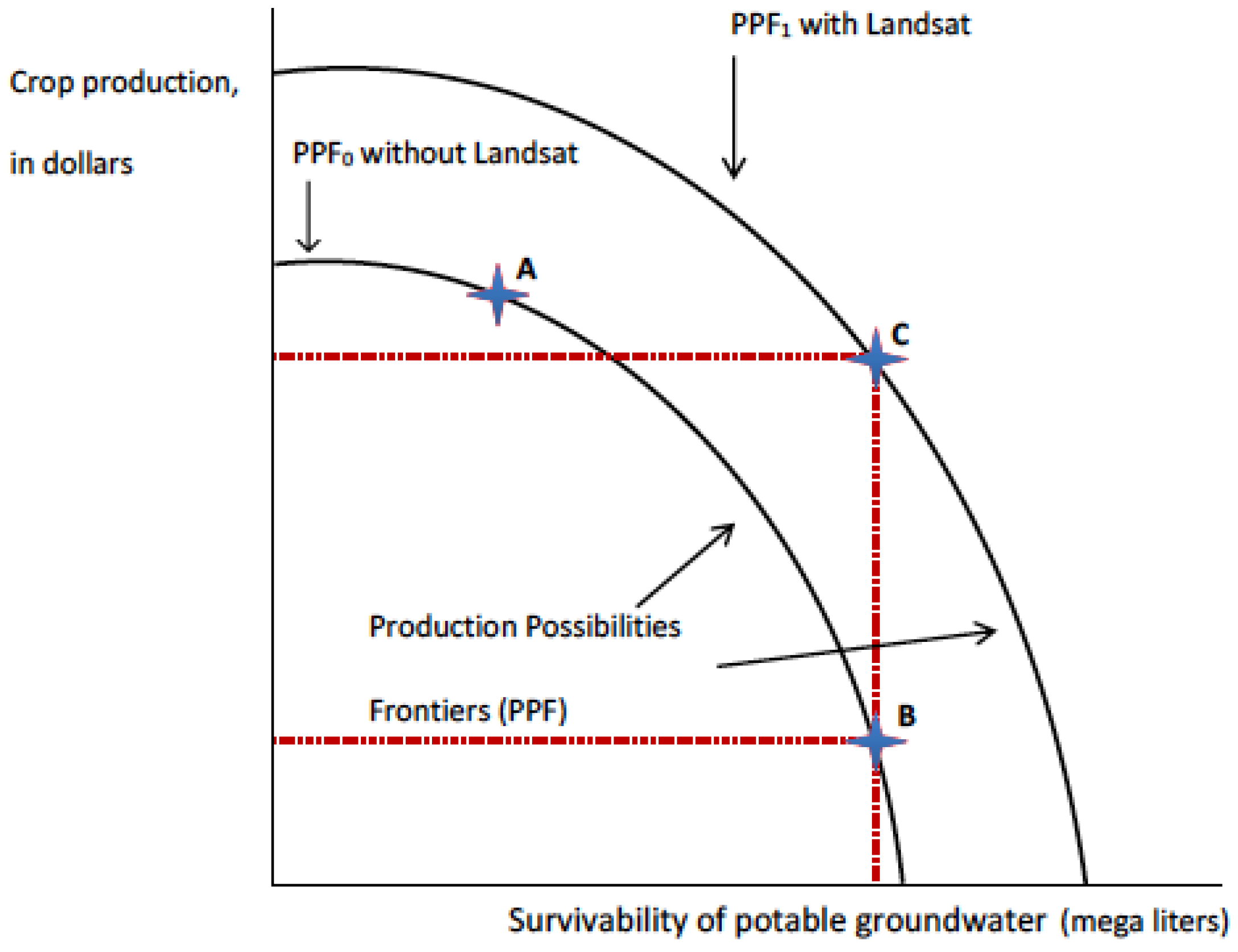
- (1)
- Decide whose benefits and costs count and identify relevant geospatial data and information;
- (2)
- Determine the potential impacts and select measurement indicators;
- (3)
- Predict the quantitative impacts of the project;
- (4)
- Monetize all impacts at a discount rate to estimate the net present value of the benefits of the project;
- (5)
- Estimate the net benefits and perform sensitivity analysis.
3. Example 1. An Inductive Retrospective Model—Environmental Regulation of Agrochemicals: Geospatial Data Provide Information for Regional Environmental and Health Policy Decisions
3.1. Background
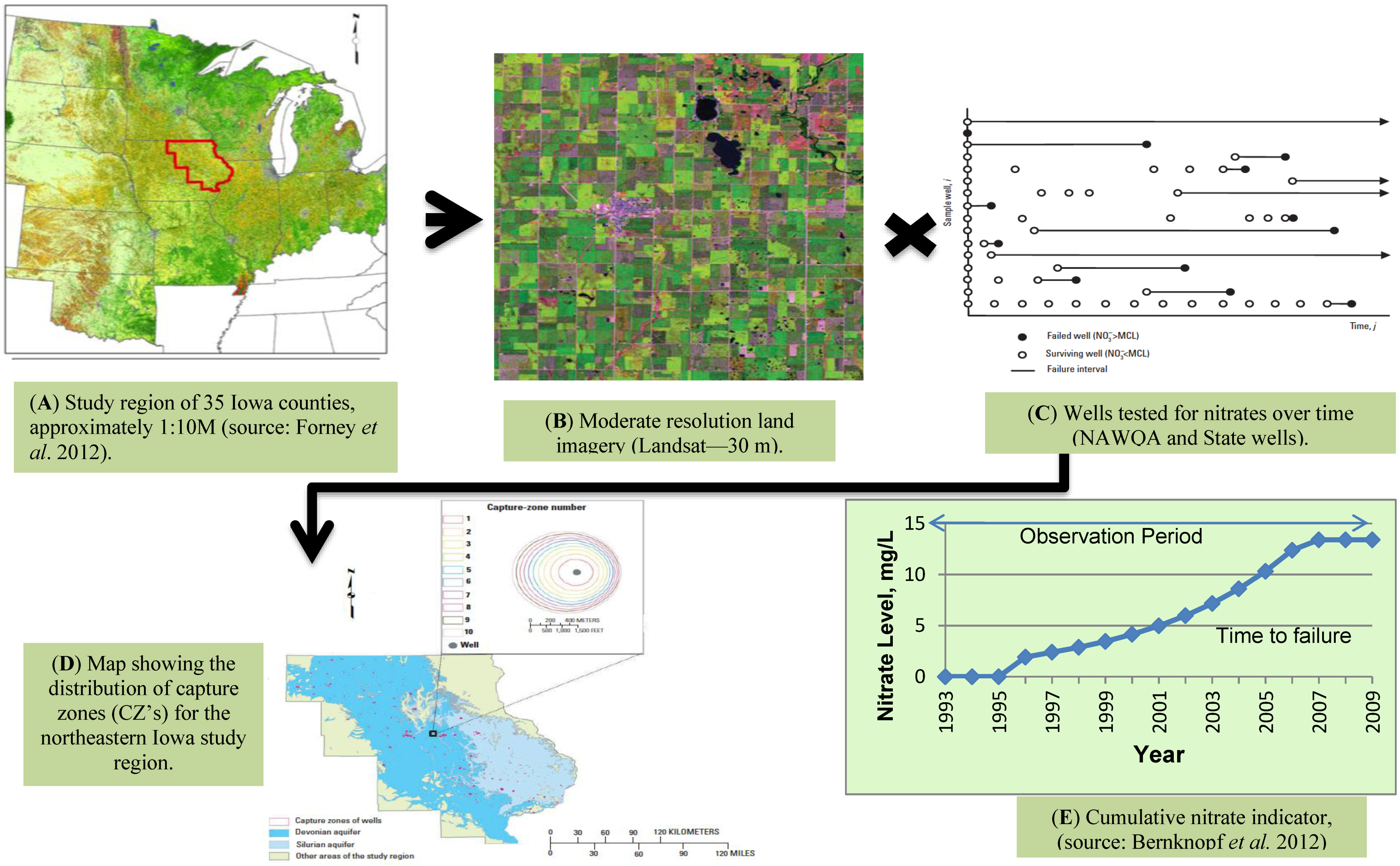
3.2. Analysis
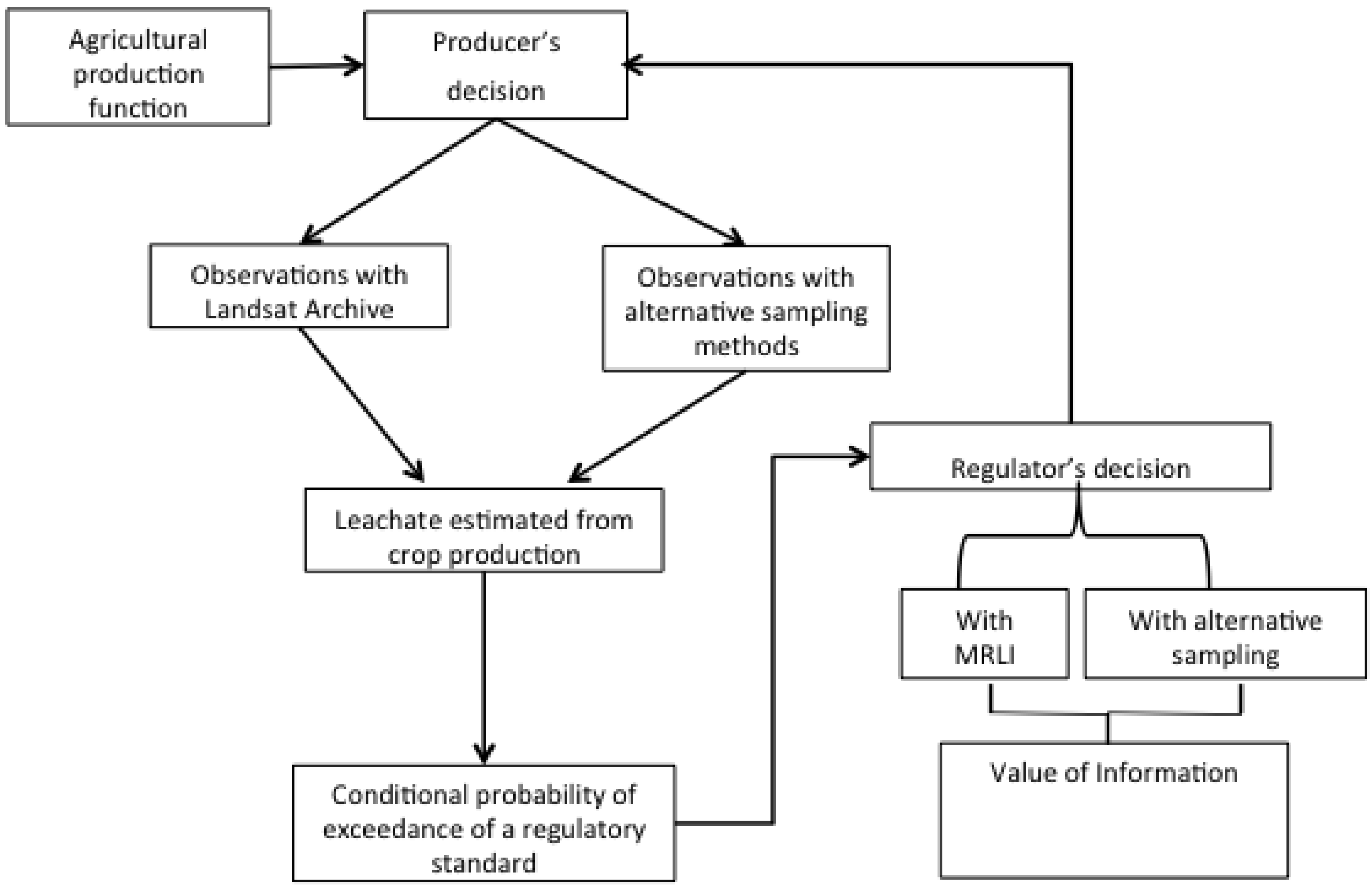
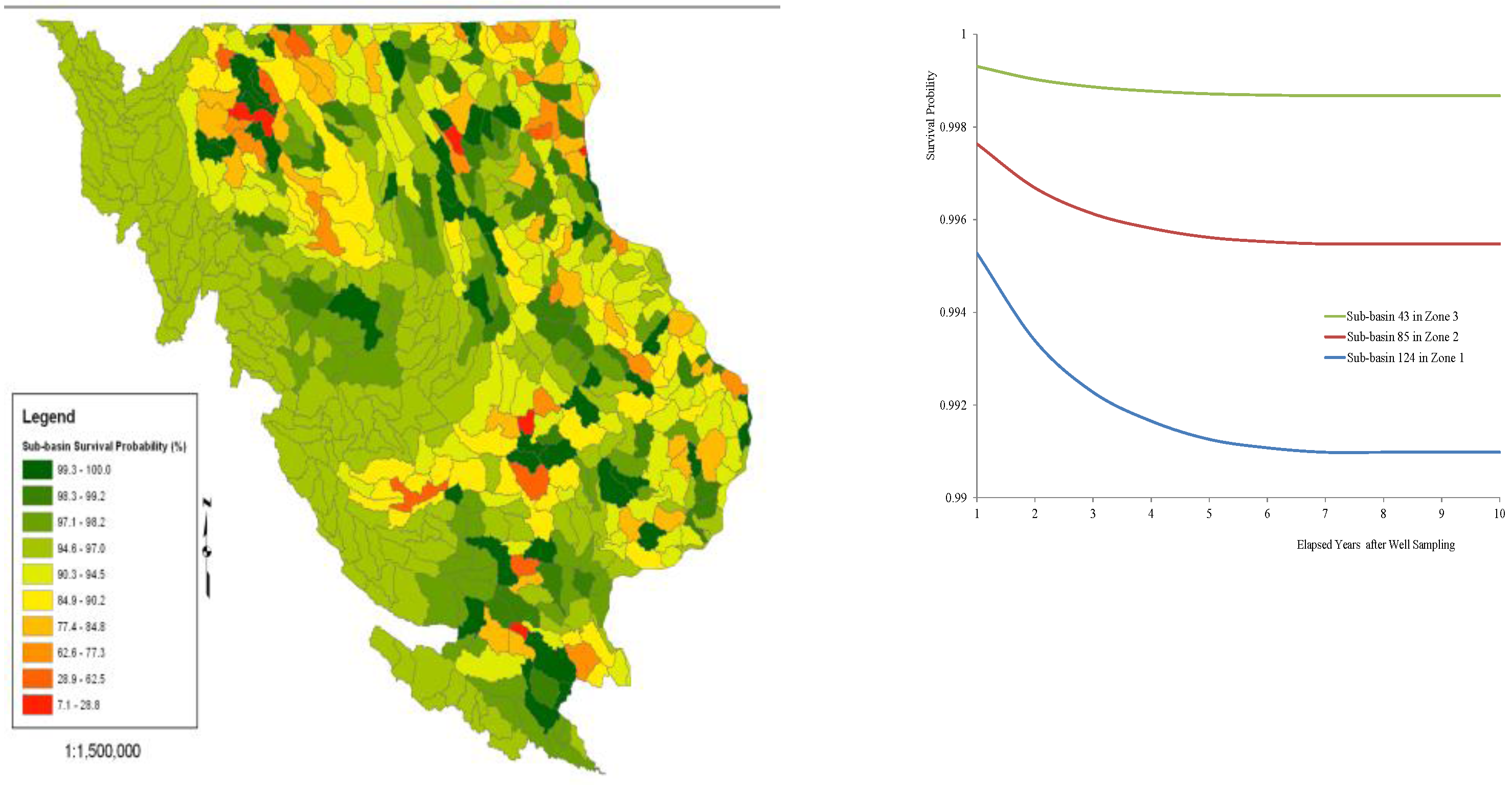
3.3. Results
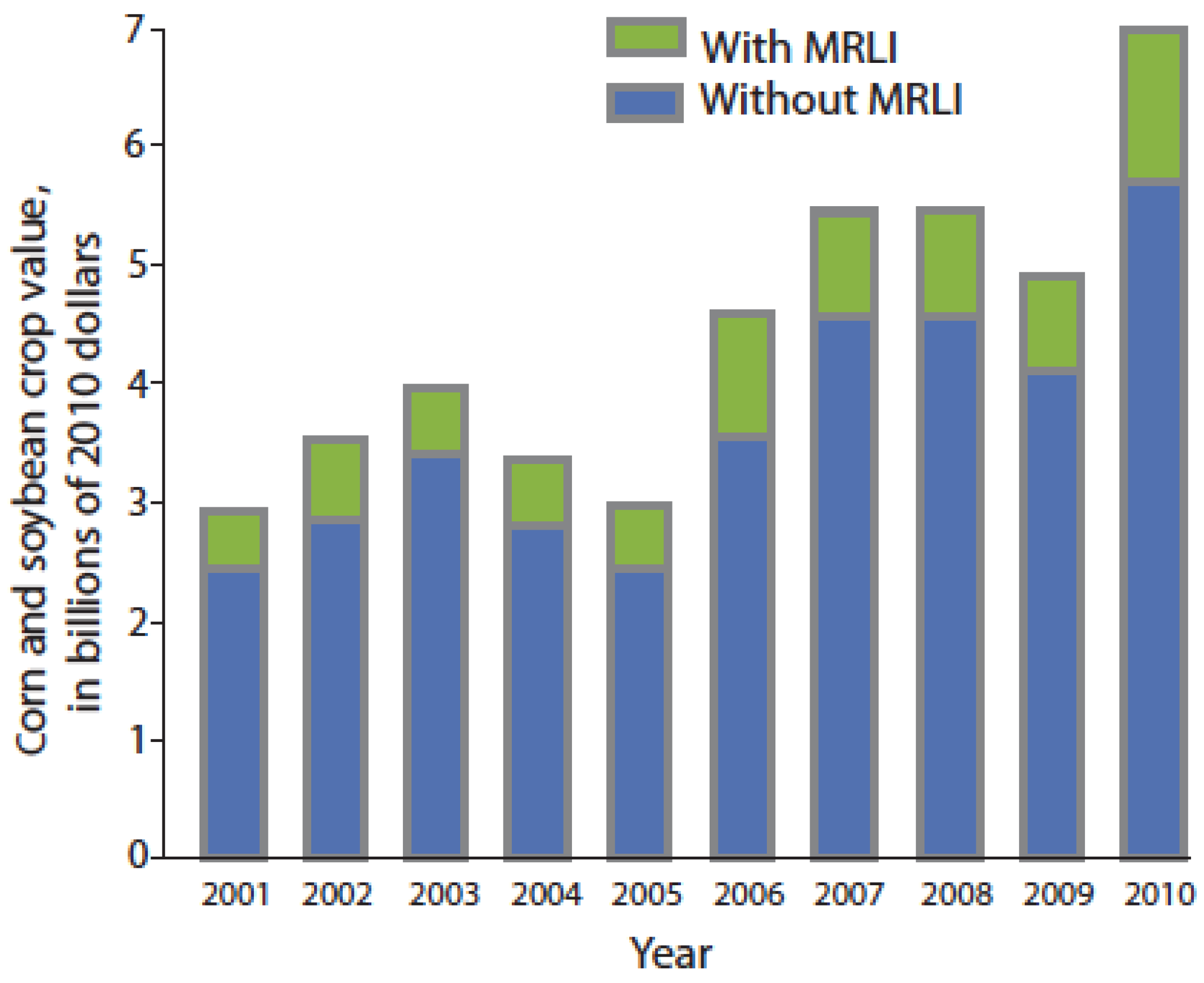
3.4. Summary
4. Example 2. An Inductive Prospective Model—An Application to Earthquake Hazards Mitigation and Income Distribution: Geospatial Information Provides Input for Earthquake Housing Risk Concentration in a Hazard Scenario for a Hazard Scenario
4.1. Background
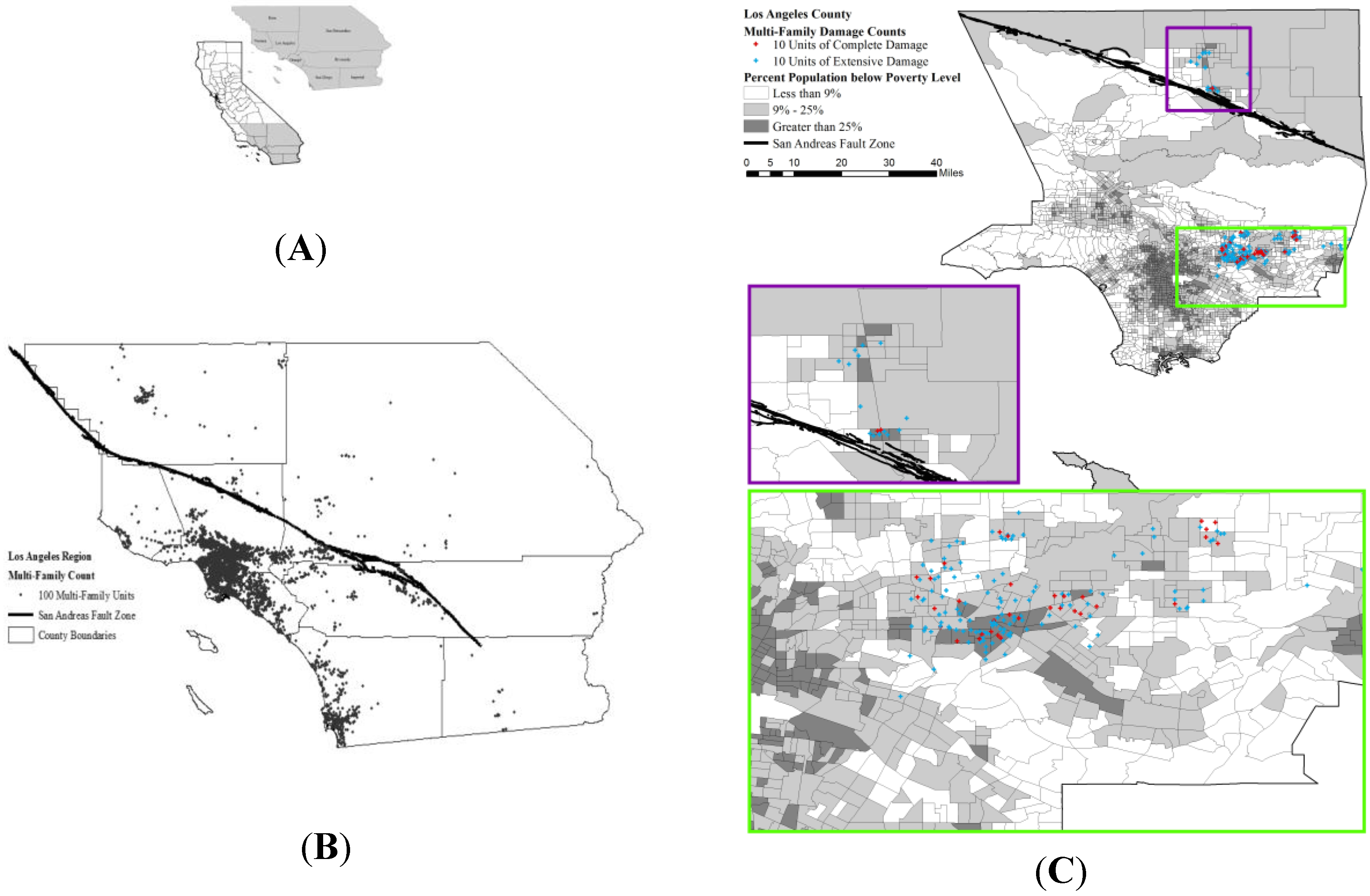
4.2. Analysis
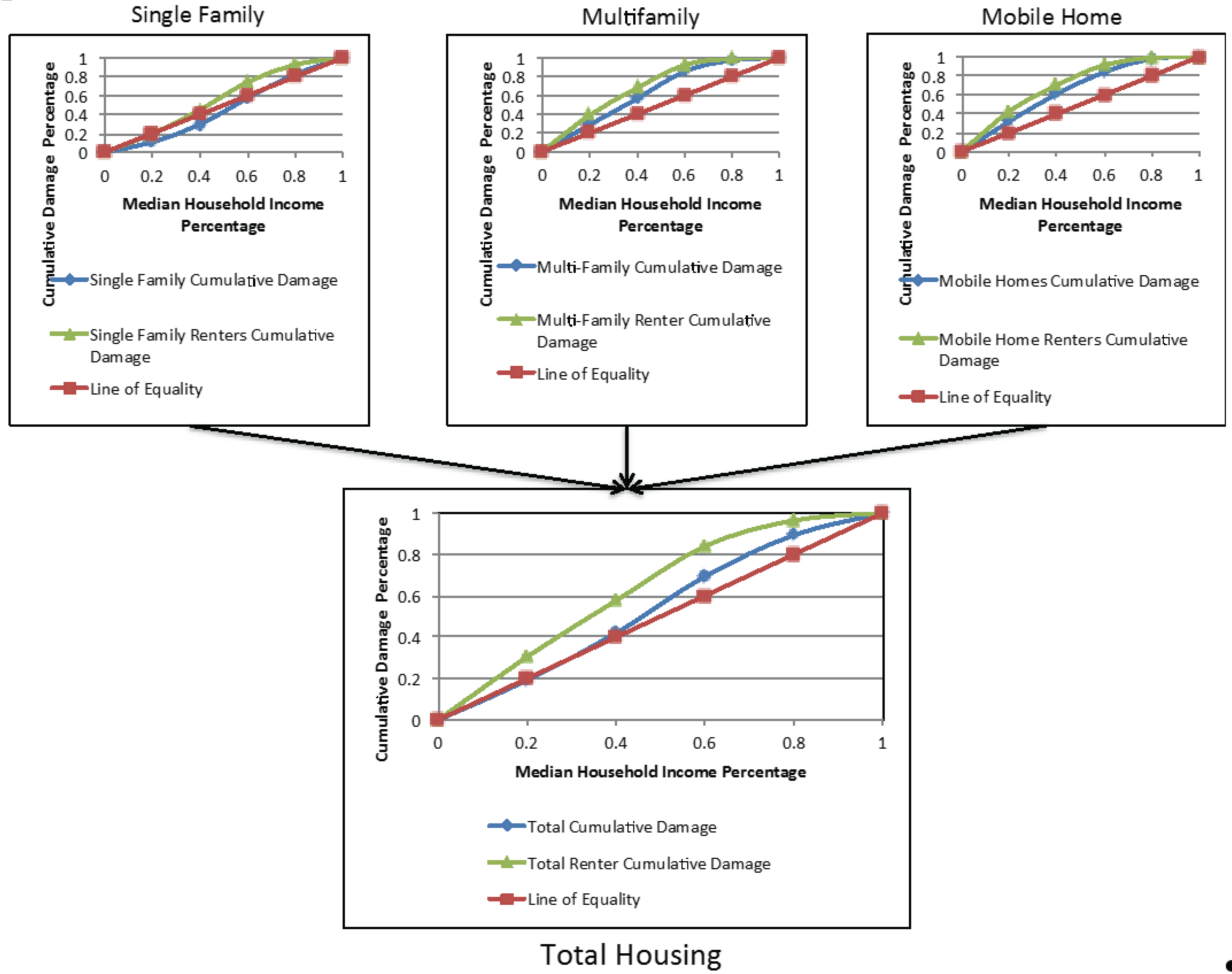
- (1)
- Apply hazard scenario to indicate the presence and significance of risk concentration by type of housing as a threshold for public sector intervention. If the risk concentration index is negative, this means there is a risk concentration for lower income groups for a given housing type.
- (2)
- Identify census tracts with damage clusters of at least 10 extensive and complete damaged multi-family buildings from the scenario. The threshold for the number of buildings at 10 was chosen as a reasonable approximation to what would be considered a significant impact to closely spaced structures in a census tract in an urban area [24].
- (3)
- Intersect damage clusters with a poverty threshold by census tract.
- (4)
- Estimate the net benefit of regulatory mitigation and compare the results of expected outcomes with voluntary mitigation for census tracts identified in steps (1)–(3). If the four criteria are met, the cost minimizing regulation program could be made available for all multi-family buildings in a census tract to avoid any missed special circumstances.
4.3. Results
4.4. Summary
5. Example 3: A Private—Public Integrated Market Model for Ecosystem Services Markets. An Application of Geospatial Information can Provide an Objective, Replicable Accounting Framework to Reduce Transactions Costs in Environmental Market(s) Activities
5.1. Background
5.2. Analysis
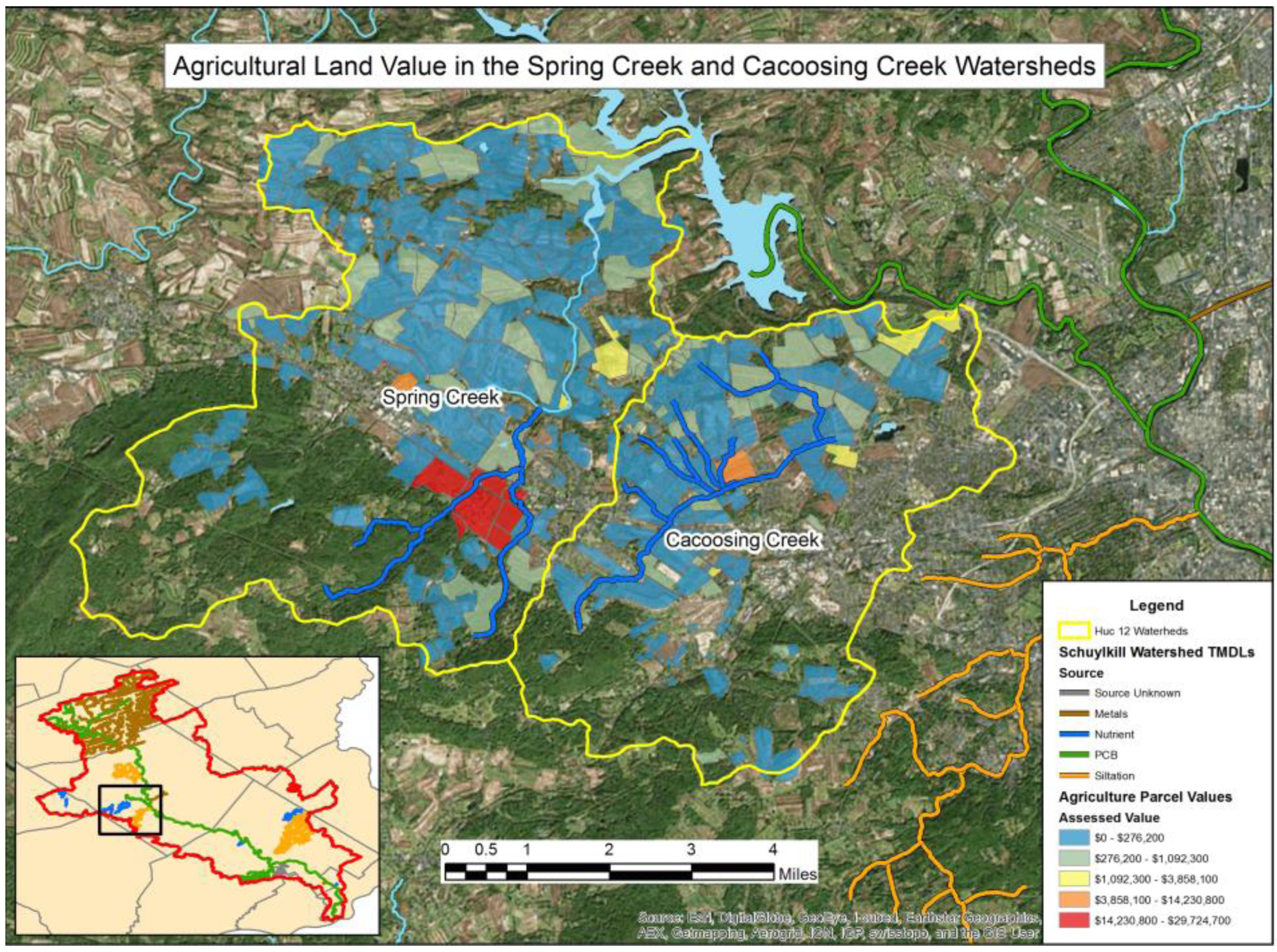
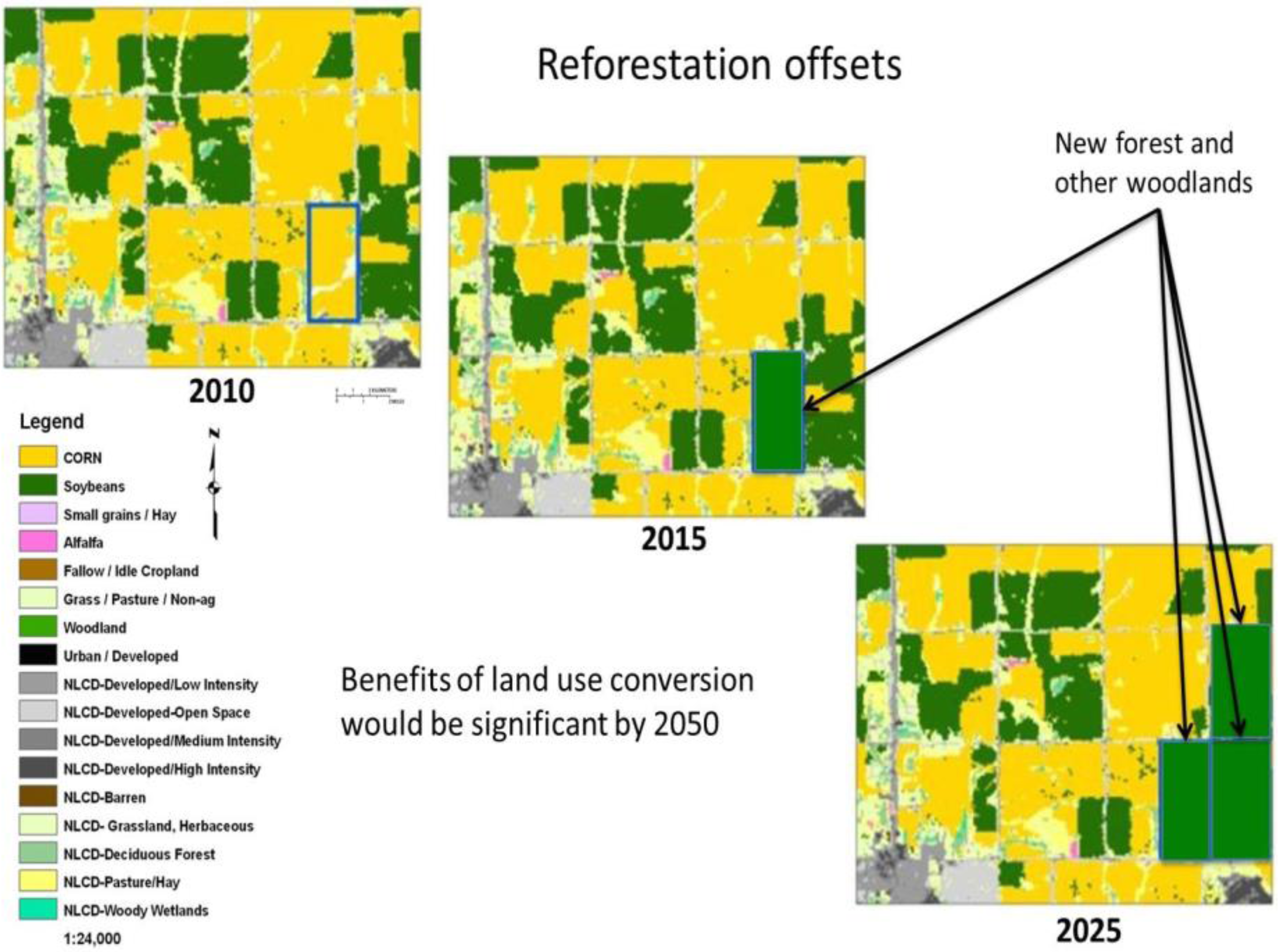
5.3. Summary
6. Conclusions
Acknowledgments
Author Contributions
Conflicts of Interest
Appendix

References
- Oxford Reference. Available online: http://www.oxfordreference.com/view/10.1093/oi/authority.20110803100023635 (accessed on 1 September 2014).
- Forney, W.; Raunikar, R.; Bernknopf, R.; Mishra, S. An Economic Value of Remote-Sensing Information—Application to Agricultural Production and Maintaining Groundwater Quality; U.S. Geological Survey: Reston, VA, USA, 2012.
- Schimmelphennig, D.; Norton, G. What is the value of agricultural economics research? Am. J. Agric. Econ. 2003, 85, 81–94. [Google Scholar] [CrossRef]
- Bemknopf, R.; Dinitz, L.; Loague, K. An Interdisciplinary Assessment of Regional-Scale Nonpoint Ground-Water Vulnerability: Theory and Application; U.S. Geological Survey: Reston, VA, USA, 2001.
- Bradford, D.; Kelegian, H. The value of information for crop forecasting in a market system: Some theoretical issues. Rev. Econ. Stud. 1997, 44, 519–531. [Google Scholar] [CrossRef]
- Bernknopf, R.; Wein, A.; Lucas, S.M.; St-Onge, M. Analysis of Improved Government Geological Map Information to Mineral Exploration: Incorporating Efficiency, Effectiveness and Risk Considerations; Geological Survey of Canada Bulletin 593; U.S. Geological Survey: Reston, VA, USA, 2007.
- Bernknopf, R.L.; Brookshire, D.S.; Soller, D.R.; McKee, M.J.; Sutter, J.C.; Matti, J.; Campbell, R.H. The Societal Value of Geologic Maps; United States Government Publishing Office: Washington, DC, USA, 1993.
- Khabarov, N.; Moltchanova, E.; Obersteiner, M. Valuing weather observation systems for forest fire management. IEEE Syst. J. 2008, 2, 349–357. [Google Scholar] [CrossRef]
- Kite-Powell, H. The value of ocean surface wind information for maritime commerce. Mar. Technol. Soc. J. 2011, 45, 75–84. [Google Scholar] [CrossRef]
- Fox, P. The Role of Virtual Observatories and Data Frameworks in an Era of Big Data. Available online: http://www.nist.gov/itl/ssd/is/big-data.cfm (accessed on 01 September 2014).
- Windrum, P.; Fagiolo, G.; Moneta, A. Empirical Validation of Agent-Based Models: Alternatives and Prospects. Available online: http://jasss.soc.surrey.ac.uk/10/2/8.html (accessed 05 April 2014).
- Wikipedia—Big Data. Available online: http://en.wikipedia.org/wiki/Big_data (accessed on 25 August 2014).
- Halsing, D.; Theissen, K.; Bernknopf, R. A Cost-Benefit Analysis of the National Map; U.S. Geological Survey: Reston, VA, USA, 2004.
- Varian, H. Intermediate Microeconomics: A Modern Approach, 6th ed.; W.W. Norton & Company: New York, NY, USA, 2003. [Google Scholar]
- What is an Inductive Method in Economics? Available online: http://sundaramponnusamy.hubpages.com/hub/What-is-an-Inductive-Method-in-Economics (accessed on 10 August 2014).
- Bernknopf, R.; Forney, W.; Raunikar, R.; Mishra, S. A general framework for estimating the benefits of moderate resolution land imagery in environmental applications. In Value of Information: Methodological Frontiers and New Applications; Laxminarayan, R., Macauley, M., Eds.; Springer Publishers: Berlin, Germany, 2012; pp. 257–300. [Google Scholar]
- Ceric, A.; Haitjema, H. On using simple time-of travel capture zone delineation methods. Ground Water 2005, 43, 408–412. [Google Scholar] [CrossRef] [PubMed]
- Yadav, S. Dynamic optimization of nitrogen use when groundwater contamination is internalized at the standard in the long run. Am. J. Agric. Econ. 1997, 79, 931–945. [Google Scholar] [CrossRef]
- Kim, C.; Hostetler, J.; Amacher, G. The regulation of groundwater quality with delayed responses. Water Resour. Res. 1993, 29, 1369–1377. [Google Scholar] [CrossRef]
- The University of Reading ECIFM Monoculture. Available online: http://www.ecifm.rdg.ac.uk/monoculture.htm (accessed on 17 July 2014).
- Raunikar, R.P.; Forney, W.M.; Benjamin, S.P. What is the Economic Value of Satellite Imagery? USGS Fact Sheet 2013–3003; U.S. Geological Survey: Reston, VA, USA, 2013.
- Jones, L.; Bernknopf, R.; Cox, D.; Goltz, J.; Hudnut, K.; Mileti, D.; Perry, S.; Ponti, D.; Porter, K.; Reichle, M.; et al. The ShakeOut Scenario; USGS Open File Report 2008–1150; USGS: Reston, VA, USA.
- Wein, A.; Johnson, L.; Bernknopf, R. Recovering from the shakeout earthquake. Earthq. Spectra 2011, 27, 521–538. [Google Scholar] [CrossRef]
- Bernknopf, R.; Amos, P. Measuring earthquake risk concentration for hazard mitigation. Natural Hazards 2014, 74, 2163–2192. [Google Scholar] [CrossRef]
- Zahran, S.; Brody, S.; Peacock, W.; Vedlitz, A.; Grover, H. Social vulnerability and the natural and built environment: A model of flood casualties in Texas. Disasters 2008, 32, 517–560. [Google Scholar] [CrossRef] [PubMed]
- Kunreuther, H.; Platt, R.; Baruch, S.; Bernknopf, R.; Buckley, M.; Burkett, V.; Conrad, D.; Davison, T.; Deutsch, K.; Geis, D.; et al. The Hidden Cost of Coastal Hazards: Implications for Risk Assessment and Mitigation; Island Press: Washington, DC, USA, 1999. [Google Scholar]
- Vigdor, J. The economic aftermath of Hurricane Katrina. J. Econ. Perspect. 2008, 22, 135–154. [Google Scholar] [CrossRef]
- Masozera, M.; Bailey, M.; Kerchner, C. Distribution of impacts of natural disasters across income groups: A case study of New Orleans. Ecol. Econ. 2007, 63, 299–306. [Google Scholar] [CrossRef]
- Comerio, M.C. Housing Repair and Reconstruction after Loma Prieta. Available online: http://nisee.berkeley.edu/loma_prieta/comerio.html (accessed on 23 June 2010).
- O’Donnell, O.; van Doorslaer, E.; Wagstaff, A.; Lindelow, M. Analyzing Health Equity Using Household Survey Data: A Guide to Techniques and Their Implementation. Available online: http://siteresources.worldbank.org/INTPAH/resources/Publications/459843-1195594469249/HealthEquityFINAL.pdf (accessed on 15 September 2011).
- Kakwani, N. Income Inequality, Welfare, and Poverty: An Illustration using Ukrainian Data. Available online: http://ssrn.com/abstract=623915 (accessed on 1 October 2011).
- Kakwani, N.; Wagstaff, A.; van Doorslaer, E. Socioeconomic inequalities in health: Measurement, computation, and statistical inference. J. Econ. 1997, 77, 87–103. [Google Scholar] [CrossRef]
- Feinstein, D. To Provide Incentives to Encourage Private Sector Efforts to Reduce Earthquake Losses, to Establish a National Disaster Mitigation Program, and for Other Purposes; U.S. Government Printing Office: Washington, DC, USA, 2001.
- Zhang, E.; Bernknopf, R.; Amos, P. Generation of a multi-permit model for ecosystem services using the portfolio approach. University of Pennsylvania: Philadelphia, PA, USA, Unpublished work; 2015. [Google Scholar]
- Bridge, B.; Brookshire, D.; Broadbent, C.; Bernknopf, R.; Pesko, S. Conceptual framework and market for nitrate loading in the Tensas river basin. University of New Mexico: Albuquerque, NM, USA, Unpublished work; 2015. [Google Scholar]
- Pacific Northwest Agencies and Partners Announce Recommendations for Regional Water Quality Trading. Available online: http://www.thefreshwatertrust.org/press-release-8132014/ (accessed on 21 September 2014).
- Willamette River TMDL East and West TMDL Alternatives Due Diligence Evaluation. Available online: http://www.corvallisoregon.gov/modules/showdocument.aspx?documentid=6360 (accessed on 20 August 2014).
- WorldView-3 Satellite Images. Available online: http://www.satimagingcorp.com/gallery/worldview-3/ (accessed 22 September 2014).
© 2015 by the authors; licensee MDPI, Basel, Switzerland. This article is an open access article distributed under the terms and conditions of the Creative Commons Attribution license (http://creativecommons.org/licenses/by/4.0/).
Share and Cite
Bernknopf, R.; Shapiro, C. Economic Assessment of the Use Value of Geospatial Information. ISPRS Int. J. Geo-Inf. 2015, 4, 1142-1165. https://doi.org/10.3390/ijgi4031142
Bernknopf R, Shapiro C. Economic Assessment of the Use Value of Geospatial Information. ISPRS International Journal of Geo-Information. 2015; 4(3):1142-1165. https://doi.org/10.3390/ijgi4031142
Chicago/Turabian StyleBernknopf, Richard, and Carl Shapiro. 2015. "Economic Assessment of the Use Value of Geospatial Information" ISPRS International Journal of Geo-Information 4, no. 3: 1142-1165. https://doi.org/10.3390/ijgi4031142
APA StyleBernknopf, R., & Shapiro, C. (2015). Economic Assessment of the Use Value of Geospatial Information. ISPRS International Journal of Geo-Information, 4(3), 1142-1165. https://doi.org/10.3390/ijgi4031142




